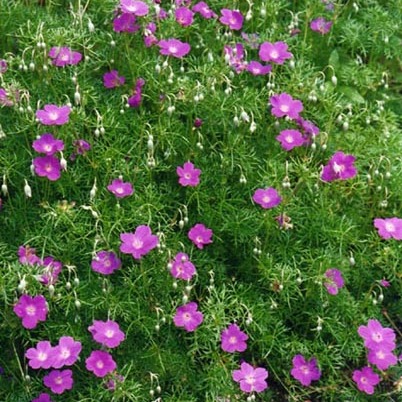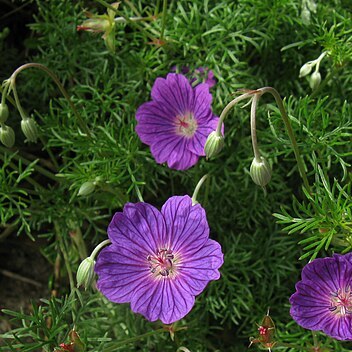A herb. It lies along the ground. It can be a climber or creeper. It keeps growing from year to year. The stems are hairy and have grooves along them. The leaves are feathery and silvery green. They have 3-7 deeply divided lobes. They are silver and felt like below. The flowers are mauve. They are 9-15 mm long and in pairs. The fruit tapers to a long point. The seeds are smooth and brown.
Leaf-lamina 3–7-lobed, divided nearly to the base; lobes 0·5–2 mm. across at base, ovate to elliptic in outline, deeply divided into linear to oblong-lanceolate segments, pilose above and tomentose below; petiole 0·5–25 cm. long, longitudinally furrowed, pilose; stipules 3–15 mm. long, lacerated nearly to the base into linear-lanceolate segments, pilose.
Diffuse perennial with thickened taproot. Leaves 3-7-lobed to base with lobes pinnatisect to bipinnatisect, long-petioled, glabrous or sparsely hairy above, densely white-hairy beneath. Flowers 1 or 2 on axillary peduncles, 15-30 mm diam., white with dark veins or pink to mauve.
Inflorescence 2-flowered; peduncle 1–13 cm. long, pilose, tomentose or glandular; pedicels 1–4 cm. long, pilose, tomentose or glandular; bracts 2–7 mm. long, linear-lanceolate, hyaline at the edge, pilose or tomentose.
Perennial herb, creeping and scrambling; stems longitudinally furrowed, pilose, but sometimes becoming nearly tomentose or densely glandular on the upper parts of the stems.
Cocci smooth, pilose; mature rostrum 13–27 × 1–2 mm., pubescent or glandular; stigmas 1–4 mm. long.
Petals 9–15 × 4–8 mm., obovate, retuse at the apex, white, pink or mauve with dark veins.
Sepals 5–10 × 2–3 mm., ovate-lanceolate, cuspidate, 3-nerved and pilose.
Seeds glabrous; testa covered with a shallow reticulate pattern.
Stamens 10, filaments about 6 mm. long, narrowly lanceolate.
Ovary pubescent; stigmas 5.


